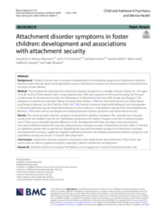Background:
Children in foster care constitute a risk population for developing symptoms of attachment disorders. However, little is known about the longitudinal course of attachment disorders and their association with attachment security in foster children.
Method:
This longitudinal study assessed attachment disorder symptoms in a sample of foster children (n = 55) aged 12 to 82 months. Foster parents with a newly placed foster child were assessed at three points during the first year of placement. At all assessment points, the Disturbance of Attachment Interview (DAI; Smyke and Zeanah in Disturbances of attachment interview, Tulane University, New Orleans, 1999) and the Attachment Q-sort (AQS; Waters and Deane in Monogr Soc Res Child Dev 50:41–65, 1985 German version as reported(Sch.lmerich and Leyendecker in Deutsche .bersetzung des attachment behavior Q-Set, revision 3.2. Unpublished manual, Ruhr UniversityBochum, Bochum, 1999) were used to investigate the interplay between disorder symptoms and attachment security.
Results:
The results revealed that the symptoms of attachment disorders decreased. The decrease was more pronounced for the inhibited than for the disinhibited symptoms with marked changes in the first 6 months of placement. There was a noticeable gender difference in the development with boys showing a more pronounced decrease in inhibited attachment disorder symptoms and a stronger increase of attachment security. After 12 months, no significant gender effects were found. Regarding the association between symptoms of attachment disorders and attachment security, a significant negative correlation between the inhibited attachment disorder symptoms and attachment security was found 12 months after placement.
Conclusions:
Attachment disorder symptoms decreased in the stable foster care environment. Thus, foster care seems to be an effective placement option regarding children’s attachment development.

